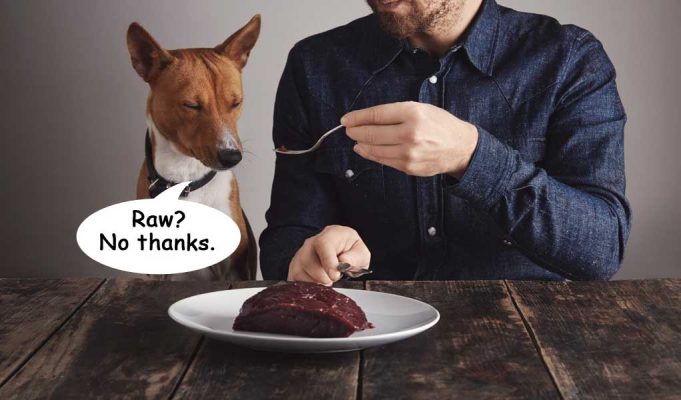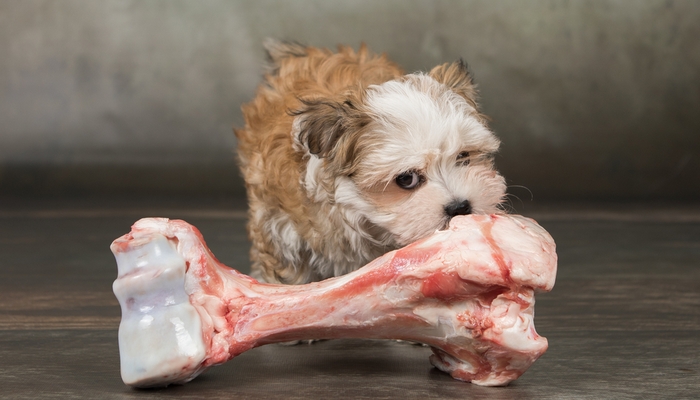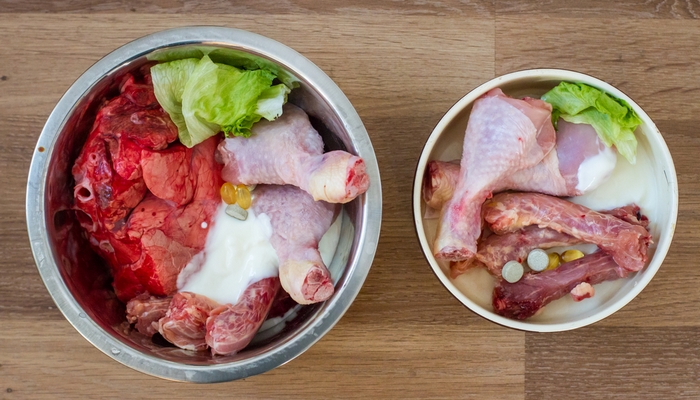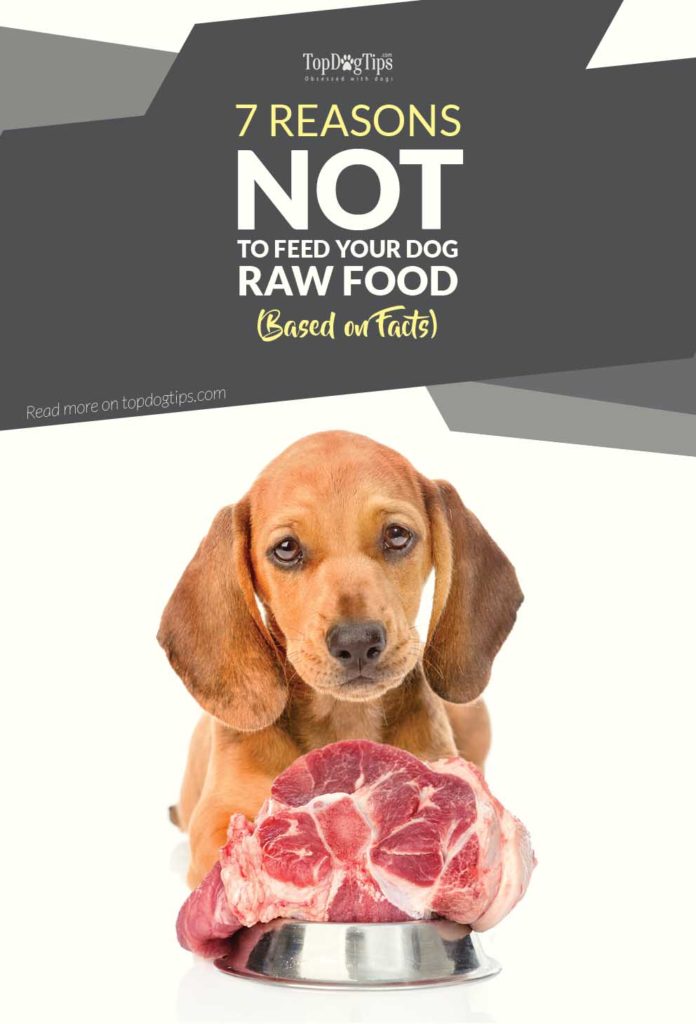Table of Contents
In recent years, the trend of feeding raw diets to dogs has been on the rise. With that rising trend comes rising controversy over the subject. Proponents of the raw dog food diet (a diet centering on raw meat, bones, fruits and vegetables) claim it is more biologically appropriate and leads to better long-term health in canines. Last week, Dom even published an article on this.
However, there is no concrete evidence to support this. Studies continue, but there is mounting evidence to support the notion that a raw diet could actually be harmful to your dog. Mainstream veterinarians and the FDA tend to oppose the raw diet, and studies supporting this opposition have been published in veterinary journals.
One study performed in 2001 concluded that raw dog food diets (both commercial and homemade) were nutrient deficient or excessive in ways which could negatively impact health significantly. This study was published in the Journal of the American Veterinary Association medical journal and have been widely referenced by vets and other studies.
The subject of raw is highly controversial, and the decision is a very subjective one. We have previously discussed BARF diet here. There's ton of information available on the subject for you to educate yourself. No matter what you decide to feed your dog, you are encouraged to consult your veterinarian, along with the latest scientific research.
Educate yourself on your dog’s breed, conditions, size, and medical history. Observe how he reacts to certain foods. And, if you decide to feed raw, just be safe and do your homework on all of the above points. We've had a dog nutrition specialist, a PhD in nutrition on one of our podcasts discussing nutrition for canines, so have a listen here.
Your dog can live a long, happy and healthy life, and that journey starts and ends with the diet you choose. Just choose what you feel most benefits your canine companion based on facts and research rather than propaganda, and be sure to seek guidance from a veterinarian or a certified canine nutritionist (with a PhD) before making the final decision.
RELATED: Raw Diet for Dogs 101 – The Ultimate Guide
7 Reasons Not to Feed Your Dog Raw Dog Food
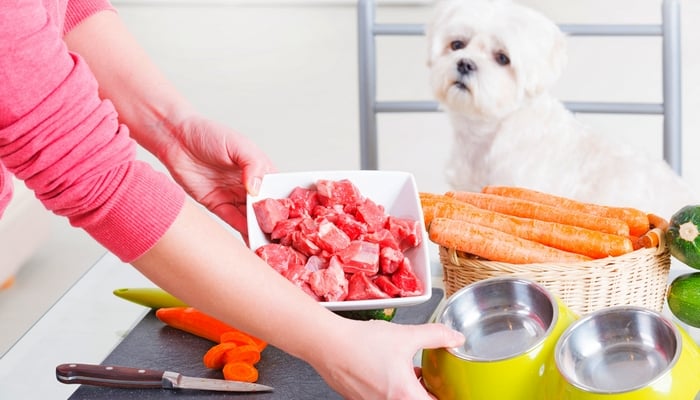 1. Bacterial contaminants
1. Bacterial contaminants
Studies of raw pet food diets show that the meats can contain bacterial contamination. Raw meat may contain any of the following:
- coli bacteria
- Salmonella
- Campylobacter
- Clostridium perfringens
- Clostridium botulinium
- Staphylococcus aureus
All of these are known to be canine (and human) pathogens. Additional canine pathogens include the following:
- Neospora caninum (found in raw beef)
- Nanophyetus salmincola (found in raw salmon)
- Trichinella spiralis (found in raw pork and wild game like as deer, elk, and moose)
These bacterial pathogens can not only cause illness, but can be fatal as well.
2. Hazards of Bones
Bones can lead to choking and puncturing of internal digestive organs. They can splinter, causing damage to the throat, stomach or intestines. Bones can also lead to chipped or broken teeth.
3. Preexisting conditions
Dogs with preexisting medical conditions can have their delicate health further negatively impacted by the nutritional deficiencies or excesses provided by a raw diet. Raw dog food diets can prove unhealthy for pets with liver issues, pancreatitis, and digestive issues.
Dogs on chemotherapy and dogs who have immunosuppressive diseases can also suffer further from a raw diet. If your dog has a chronic disorder or disease, you should only administer the diet recommended by your veterinarian.
RELATED: 11 Best Superfoods for Dogs That May Improve Their Health
4. Improper ratios
Puppies need the proper balance of calcium, protein, fat, calcium, and phosphorous. Without these balances in place, they can suffer from stunted growth and bone deformation. This may also lead to dental issues (as teeth are bones).
For puppies and adult dogs alike, too much vitamin A can be toxic over an extended period of time. Raw dog food diets high in liver contain excessive vitamin A. It's tough to find the right ratios of nutrients when feeding a raw diet.
5. Nutritional Deficiencies
The simple truth is that most dog owners are not veterinarians. Getting the nutritional balance of your dog’s food correct is a science. Raw diets not properly prepared can be deficient in vital nutrients, which will have a negative impact on your dog’s health over time.
The problem with nutritional deficiencies is that they take a long time to present. So, you likely will not notice an issue in your dog’s health until he has had the issue for a long time.
6. Digestibility
It is difficult for dogs to digest raw vegetables. In fact, most of the nutrients in vegetables become more available to dogs after they are cooked and ground. Raw vegetables are often poorly digested by dogs.
7. Expense
Making or purchasing raw diets can be costly, time consuming, and inconvenient. The ingredients required for homemade recipes are numerous, and spoil quickly. The recipes can take a lot of time and effort to put together, and they must be made often.
It is very difficult to travel with raw food as well. It's also hard to provide this diet to a dog who is being watched by a friend or boarding facility. And it is difficult to store, requiring refrigeration and freezing.
RELATED: 15 Cheap Ways To Prevent Most Common Health Issues in Dogs
Countering the Raw Proponents and Dispelling Myths
People who support raw diets for dogs have their own claims about why is it necessary and effective. But, some of those arguments make claims which may not be valid or true. Here are a few:
Myth #1: Dogs are Wolves, and Should Eat Like Wolves
Raw advocates surmise that because dogs evolved from wolves (who are carnivores), it is only logical that they should eat as wild wolves eat – namely, carcasses. The problem is that domesticated dog species are significantly removed from wolves.
Dogs have been evolving alongside man as our companions for at least 18,000 years, and dogs broke away from wolves genetically speaking approximately 40,000 years ago. This leaves a lot of time for evolution.
Dogs, unlike cats, are not obligate carnivores. They are omnivores, and as such, they can handle a variety of foods for digestion. In fact, wolves eat a substantial amount of vegetable matter in the wild.
Myth #2: Commercial Diets Lack Proper Nutritional Content
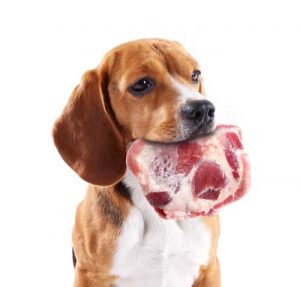 Commercial diets are scientifically formulated according to AAFCO standards to be in accordance with the complex nutritional profiles and requirements of dogs. The science of creating good, nutritionally balanced foods is a never ending endeavor.
Commercial diets are scientifically formulated according to AAFCO standards to be in accordance with the complex nutritional profiles and requirements of dogs. The science of creating good, nutritionally balanced foods is a never ending endeavor.
Veterinarians and nutritional experts learn more every year about how to improve upon formulated dog foods.
The foods are tested in feeding trials extensively before hitting market shelves. On the other hand, commercial raw diets are less often tested, and homemade diets almost never are.
Raw diets are therefore unlikely to be as nutritionally balanced as commercially produced and vigorously tested dog foods. It's just a fact.
I recommend reading this article from the people who know much better than I do.
Myth #3: Commercial Diets Cause Canine Illness
There is no real evidence to support this claim. Furthermore, because dogs are living longer now than they used to, there is a higher prevalence of age-related illnesses in our canine companions.
Myth #4: Dogs React Badly to Grains
Lab testing actually demonstrates that cooked grains can be a great source of energy for dogs, along with providing protein and other nutrients. The claim that dogs cannot digest grains is also not valid; as stated above, dogs are omnivores who are capable of digesting a variety of foods besides meat.
People also blame grains for food allergies in dogs. While this can be true, it is more often the case that dogs are allergic to meat than to other food sources.
Myth #5: Cooking Dog Food Has Negative Affects
Raw proponents claim that cooking food can destroy all the nutrients. While it stands to reason that cooking does deplete some nutritional content, there is a science to cook at the correct temperatures to retain maximum nutrition. And it is important to remember that cooking is the key to destroying the things we want to destroy in food – pathogens.
READ NEXT: 3 Common Canine Diseases Linked to Dog Food


